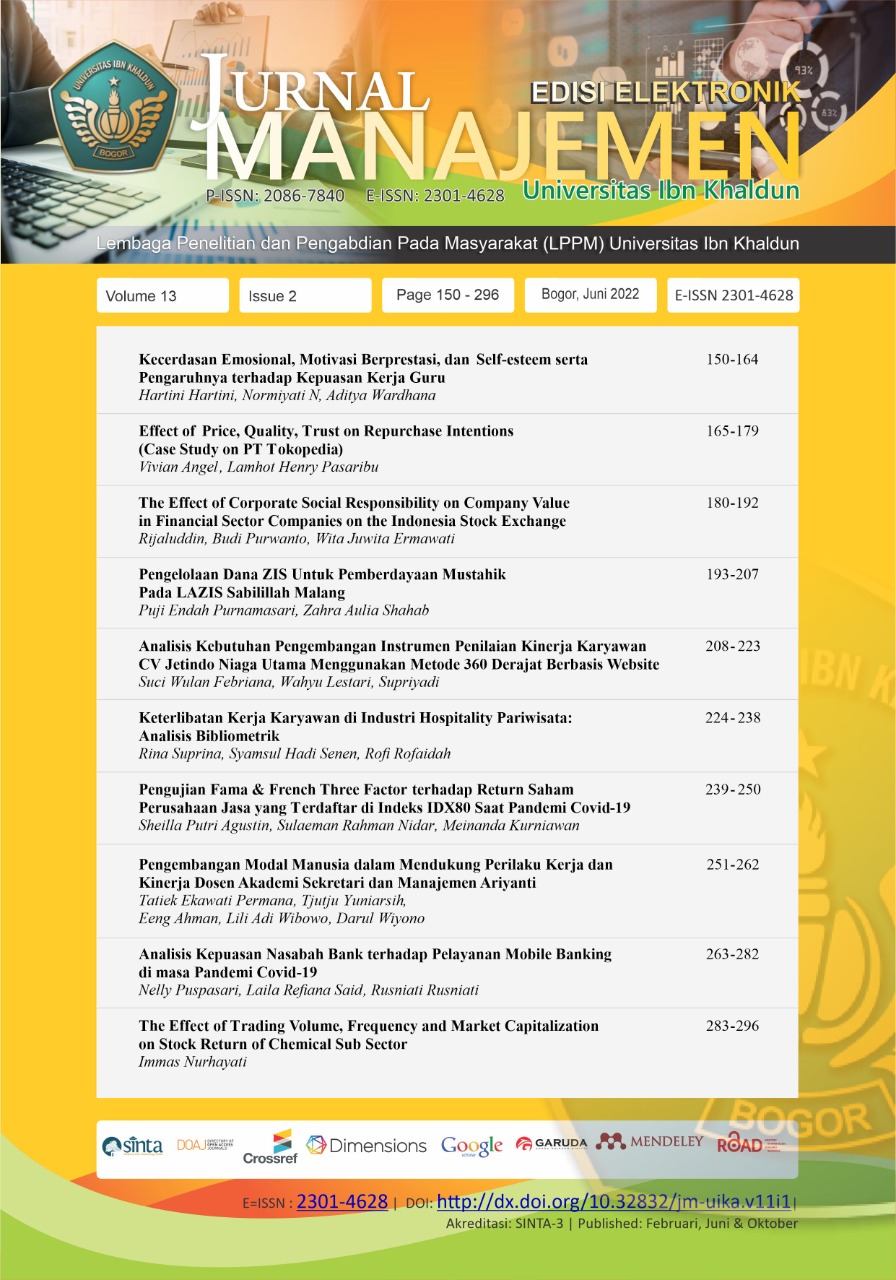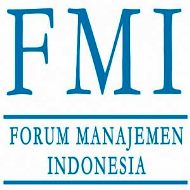Pengembangan Human Capital Dalam Mendukung Perilaku Kerja dan Kinerja Dosen Akademi Sekretari dan Manajemen Ariyanti
DOI:
https://doi.org/10.32832/jm-uika.v13i2.6958Keywords:
Education, Intellectual Capital, Work Behavior, PerformanceAbstract
Research problems are related to the quality of human resources from the aspects of intellectual capital and the performance of the tridharma of lecturers in the fields of education and teaching, research and scientific publications and community service. Interventions needed to resolve Human Resources and performance problems can be carried out through a process of training and intellectual capital development. This study aims to examine and evaluate the contribution of formal education and non-formal education variables in supporting the development of intellectual capital, work behavior and performance of Ariyanti Academy of Secretarial and Management lecturers. This type of research is a quantitative study using a survey method at the Academy of Secretary and Management Ariyanti through giving questionnaires to 59 lecturers. The results of the research found that: (1) formal education and non-formal education contributed positively and significantly in supporting intellectual capital, (2) work behavior contributed positively and significantly in supporting the performance of the tridharma of lecturers, and (3). intellectual capital contributes positively and significantly in supporting the tridharma performance of Ariyanti Academy of Secretarial and Management lecturers.
References
Afandi, P. (2018). Manajemen Sumber Daya Manusia (Teori, Konsep dan Indikator). Riau: Zanafa Publishing.
Alwi, Syarifuddin. (2001). Manajemen Sumber Daya Manusia: Strategi Keunggulan Kompetitif, Ed. Pertama, Yogkarta: BPFE.
Ancok, Jamaludin. (1994). Psikologi Islam, Yogyakarta: Pustaka Pelajar.
Anwar Prabu, M. (2017). Manajemen Sumber Daya Manusia Perusahaan, Bandung: PT. Remaja Rosdakarya.
As‘ad. Mohammad. (2001). Psikologi Industry. Yogyakarta: Liberty.
Barney, Jay. (1991). Firm Resources and Sustained Competitive Advantage, Journal of Management, 17(1).
Blumberg, Melvin dan Charles D. Pringle. (1982). The Missing Opportunity in Organizational Research: Some Implication for a Theory of Work Motivation, Academy of Management Review, 7, 563-569.
Bontis, Nick, Nicola C. Dragnetti, Kristie Jacobsen dan Goran Ross. (1999). The Knowledge Toolbox: A Review of the Tools Available to Measure and Manage Intangible Resources, Europa Management Journal, 17(4).
Bratianu, C., & Pinzaru, F. (2015). University governance as a strategic driving force. Proceedings of 11th European Conference on Management Leadership and Governance, (pp. 28-35). Military Academy, Lisbon, Portugal.
Burr, Renu and Antonia Girardi. (2002). Intellectual Capital: More Than the Interaction of Competence x Commitment. Australian Journal of Management. Sydney. 77-78.
Cherrington J, David. (1995). Organizational Behavior; The Management of Individual & Organizational Performance, Allyn & Bacon, USA.
Chien, Yung-Chieh. (2013). The Effects of Organizational Performance on the Intellectual Capital Accumulation of Taiwan-listed Biotechnology Companies: Organizational Citizen Behavior as a Moderator, The Journal of Human Resource and Adult Learning, 9(1), 40-54.
Edison, Emron, Anwar, Yohny & Komariyah, Imas. (2016). Manajemen Sumber Daya Manusia. Bandung: Alfabeta.
Goleman, d. (1995). Emotional Intelligence: Why It Can Matter More Than IQ For Character, Health and Lifelong Achievement. Bantam Book. New York.
Goleman, D. (2000). Kecerdasan emosional. Ed. Pertama. Terjemahan. Jakarta: PT Gramedia Pustaka Utama.
Hair, Joseph E, Jr et al. (2014). A Primer on Partial Least Squares Structural Equation Modelling (PLS-SEM). SAGE Publications, Inc. California. USA.
Han Y., and Dayuan Li. (2015). Effects of intellectual capital on innovative performance, The role of knowledge-based dynamic capability. Management Decision, 53(1), 40-56, http://dx.doi.org/10.1108/MD-08-2013-0411.
Hasibuan, Malayu S.P. (2003), Manajemen Sumber Daya Manusia, Jakarta: Bumi Aksara.
Hermawan, Sigit, (2012). Peran, Pengelolaan, dan Pemberdayaan Intellectual Capital, Serta Perbaikan Praktik Bisnis Industri Farmasi, Disertasi, Pascasarjana Fakultas Ekonomi dan Bisnis, Universitas Airlangga Surabaya.
Hurwitz, J., S. Lines, B. Montgomery, dan J. Schmidt. (2002). The Linkage Between Management Practice, Intangible Performance and Stock Returns. Journal of Intellectual Capital, 3(1), 51-61.
Johanson, U., M. Martenson., dan M. Skoog. (1999). Measuring and Managing Intangibles, Eleven Swedish Qualitative Exploratory Case Studis. Accounting for Intangible and the Virtual Organization, Brussels.
Jusriadi, Edi. (2017). Pengembangan Komponen Intellectual Capital dalam mendukung perilaku kerja dan kinerja dosen PTM. Disertasi. Pascasarjana Universitas Airlangga: Surabaya.
Kasmir. (2016). Manajemen Sumber Daya Manusia. Depok: PT Rajagrafindo Persada.
Kaswan dan Ade Sadikin, Akhyadi. (2015). Pengembangan Sumber Daya Manusia: Dari Konsepsi, Paradigma, dan Fungsi Sampai Aplikasi, Cet-1, Bandung: Alfabeta.
Lestari AS, Dirga. (2014). Determinan Pengembangan Karier Dosen Pada Perguruan Tinggi Di Samarinda. Disertasi Tidak Dipublikasikan. Makassar: Pascasarjana Universitas Hasanuddin.
Lev, B. (2001). Intangible: Management, Measurement, and Reporting. Washington: The Brooking Institution.
Nasir. Muhammad. (1999). Metode Penelitian. Jakarta: PT Ghalia Indonesia.
Nejadirani, Farhad, and Farokh Ghorbani Namvar. (2011). Examining the Effects of Intellectual Capitals Management on Organizational Performance, The Case Study. Research Journal of Applied Sciences, Engineering and Technology 4(9), 1040-1050.
Nothnagel, K. (2008). Empirical Research Within Resource Based Theory: A Meta Analysis of the Central Propositions. Germany: Gabler.
Notoatmodjo, Soekidjo. (2003). Pendidikan dan Perilaku Kesehatan. Jakarta: Rineka Cipta.
Obeidat, et al. (2017). The Effect of Intellectual Capital on Organizational Performance, The mediating Role of Knowledge Sharing. Communication and network, 9, 1-27.
Pulic. (2000). VAIC - An Accounting Tool for IC Management. International Journal of Technology Management, 20(5).
Raharjanti, P. 2015. Hubungan Dan Pengaruh Intellectual Capital Terhadap Kinerja Perusahaan Sektor Keuangan di Indonesia. Disertasi. Universitas Diponegoro Semarang.
Ramírez, Y. (2013). Intellectual capital management and reporting in European higher education institutions. Intangible Capital, 9(1).
Ramirez, Y., dan S. Gordillo. (2007). Recognition and measurement of intellectual capital in Spanish universities. Journal of Intellectual Capital, 15(1), 173-188.
Robbins, Stephen, P, (1996). Organizational Behavior: Concept controversies, applications, Seventh Edition, Englewood Cliffs, New Jersey: A Simon & Schuster Company.
Robbins, Stephen, P, (2003). Perilaku Oragnisasi, Konsep, Kontroversi, dan Aplikasi. Edisi Bahasa Indonesia, Jakarta: Salemba Empat.
Rusydi, Muhammad, (2014). The Effect Leadership and Empowerment on competence and job performance lecturer the IX Region Kopertis in Macassar city. Disertasi. Makassar: Pascasarjana Universitas Hasanuddin.
Sawarjuwono, Tjiptohadi, (2012). Aspek Perilaku Manusia dalam Dunia Akuntansi: Akuntansi Keperilakuan. Cet-1, Surabaya: Pusat Penerbitan dan Percetakan Unair (AUP).
Sen, Zhou. et al., (2014). How Intellectual Capital Reduces Stress on Organizational DecisionMaking Performance: the Mediating Roles of Task Complexity and Time Pressure, Proceedings of the 11th International ISCRAM Conference–University Park, Pennsylvania, USA, May 2014, S.R. Hiltz, M.S. Pfaff, L. Plotnick, and P.C. Shih, eds. 220-224.
Spahic, Ehlimana, (2014). Models for measurement of national intellectual capital - a case study of the skandia navigator model. Economic and Social Development, 7th International Scientific Conference, New York City. pp. 152-166.
Spencer, M. Lyle and Spencer, M. Signe. (1993). Competence at Work: Models for Superior Performance. New York, USA: John Wily & Son, Inc.
Stevens, Roxanne Helm, (2012). Comparison and Association of Intellectual Capital: An Investigation and Measurement of the Value of Intellectual Capital Assets and their Contribution to Stakeholder Perception Within the Framework of Higher Education, Disertation publishing: UMI 3491610.
Stewart, Thomas, A., (1997). Intellectual Capital the New Wealth of Organization, London: Nicholas Brealey.
Stewart, Thomas, A., (1998). Intellectual Capital: Kekayaan Baru Organisasi, Alih Bahasa: Reza Gunawan, Jakarta:PT Alex Media Komputindo.
Stoner, J. (2005). Manajemen. Jakarta: Prenhalindo.
Suliswiyadi, (2011). Pengembangan Nilai Keberagamaan Pada Pendidikan Agama Di SLTA Muhammadiyah Kabupaten Magelang. Disertasi Tidak Dipublikasikan. UIN Sunan Kalijaga Yogyakarta.
Sveiby, K. E. (2001). A Knowledge-Based-Theory of the Firm to Guide in Startegy Formulation. Journal of Intellectual Capital, 2(4), pp. 344-358.
Swanson, Richard A and Elwood F. Holton III. (2001). Foundations of Human Resource Development. San Francisco: Berrett-Koehler Publisher, Inc (BK).
Swanson, Richard A and Elwood F. Holton III. (2009). Foundations of Human Resource Development. Second edition, San Francisco: Berrett-Koehler Publisher, Inc (BK).
Ulrich, Dave., (1997). Human Resource Champions. Boston: Harvard Business School Press. Wright.
Ulrich, Dave., (1998). A New Mandate for Human Resources. Harvard Business Review, 7(1), 124-135.
Ulrich, Dave., (1998). Intellectual Capital = Competence x Commitment. Sloan Management Review, 39, 15-26.
Undang-Undang Nomor 14 Tahun 2005 Tentang Guru dan Dosen, Jakarta: Diknas.
Undang-Undang Nomor 20 Tahun 2003 Tentang Sistem Pendidikan Nasional, Jakarta: Diknas.
Wernerfelt, Birger, (1984). A Resource Based View of the Firm. Strategic Management Journal, 5, 171-180.
Zomorrodian, Asghar, (2014). Strategic human capital: approaches & models for achieving organizational long-term competitiveness and sustainability, Proceedings of ASBBS, 21(1). 754-771.
Downloads
Published
How to Cite
Issue
Section
License
Authors who publish with this journal agree to the following terms:
- Authors retain copyright and grant the journal right of first publication with the work simultaneously licensed under a Creative Commons Attribution-NonCommercial-ShareAlike 4.0 International License that allows others to share the work with an acknowledgement of the work's authorship and initial publication in this journal.
- Authors can enter into separate, additional contractual arrangements for the non-exclusive distribution of the journal's published version of the work (e.g., post it to an institutional repository or publish it in a book), with an acknowledgement of its initial publication in this journal.
- Authors are permitted and encouraged to post their work online (e.g., in institutional repositories or on their website) prior to and during the submission process, as it can lead to productive exchanges, as well as earlier and greater citation of published work (See The Effect of Open Access).











